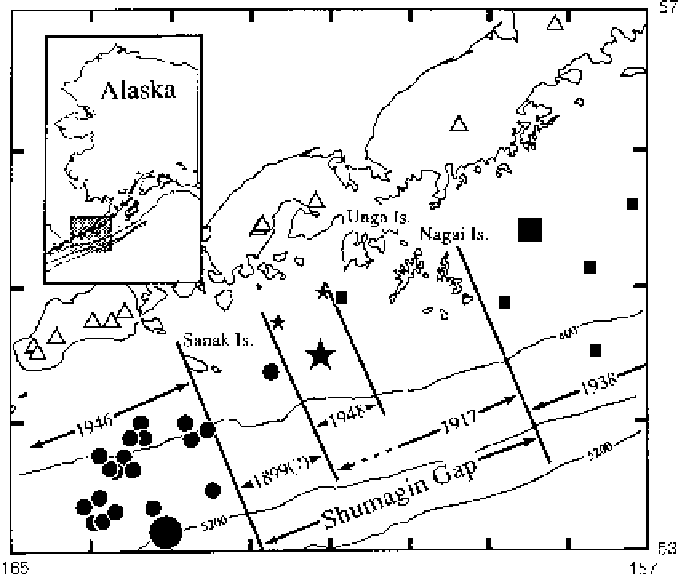Geoscience Reference
In-Depth Information
Figure 9.51.
Part of the Aleutian Arc, showing the location of the Shumagin gap in
relation to the previous large earthquakes in the region. Main shocks and aftershock
sequences are shown as well as estimates of the extent of rupture for each event:
1938,
M
w
•
1948,
M
S
= 7.5. The 1993,
M
S
= 6.9,
earthquake ruptured a small part of the Shumagin gap. Probable rupture extents of
the 1917,
M
S
=
8.3;
1946,
M
w
=
7.3 and
=
7.9, and the 1899,
M
S
=
7.2, events are also shown. The great 1964,
9.2, earthquake was to the east at 154
◦
W, 56.5
◦
N.
M
w
, locations of volcanoes.
Bathymetric contours are in metres. (After Boyd
et al
.(1988).)
=
largest earthquake (
M
8.2) ever to affect Mexico took place on the Rivera
subduction zone in 1932. Until a shallow
M
w
∼
8.0 earthquake occurred in
1995, there was concern that this subduction zone was locked. Faulting from this
earthquake, which originated near the Cocos-Rivera plate boundary, was mainly
along the Rivera-North America plate boundary.
Figure 9.53 shows the slow build-up of deformation that takes place when
a subduction zone is locked and the sudden motions that occur when a great
earthquake occurs. In the 1964 Alaska earthquake (
M
W
=
9.2) there was over
2m of subsidence behind and over 6 m of uplift in front of the epicentre. That
the Cascadia subduction zone is currently locked is illustrated in Fig. 9.54; the
measured uplift is consistent with a numerical thermal model having part of the
subduction zone locked. The uplift measured in Japan is also consistent with such
a model.
=

